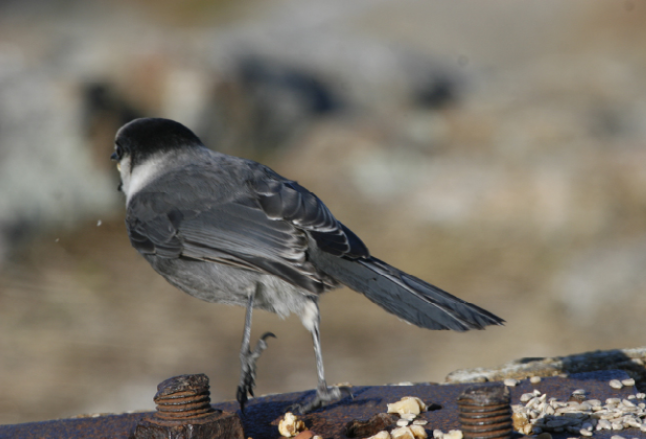
Wayne R. Petersen
A glance at the thickness and length of the legs of this issue’s mystery species suggests that it is not an especially small bird, an impression reinforced by the length of its unmarked tail in relation to the rest of its body. The back and wings of the bird are unmarked by wing bars or other conspicuous markings, and—when the image is viewed in color—the bird’s back is almost entirely a uniform medium gray. The only contrast is between the black on the back of the head and the white on the neck and cheek. Even the underparts exhibit little contrast when compared to the back and wings. In summary, we are left with a medium-sized bird relatively devoid of any overall conspicuous markings.
The general shape of the bird, the length of its tail, and the length and thickness of its legs are reminiscent of a thrush. Though the Townsend’s Solitaire is similarly gray-backed, it would have a uniformly gray head lacking a black cap and nape, and a complicated wing pattern instead of the plain gray wings of the mystery species. The mystery bird shows an overall resemblance to the much smaller and slimmer Black-capped Chickadee—a species that also shares the appearance of black on the back of its head and white cheeks—but a chickadee would also tend to exhibit conspicuous white edges to the secondaries, possess contrasting light flanks compared to its gray back, and would have noticeably thinner legs.
Having thus eliminated all of the similarly colored bird species in Massachusetts, there’s only one that most closely matches the mystery bird: Canada Jay (Perisoreus canadensis). The black back to the head, white neck and cheek markings, and uniform gray dorsal color are diagnostic. The only additional distinctive features not readily observable in the photograph of this adult Canada Jay are its short, stout bill and the white tips to its tail feathers.
Canada Jays are rare and irregular winter visitors in Massachusetts, with most records occurring in central and western parts of the state. Some Canada Jay occurring in the state have been visitors at feeders, and others have been discovered in more remote wooded areas. In New England, relatively small numbers of Canada Jays live and breed in the more northern or mountainous regions of Maine, New Hampshire, and Vermont.
The author photographed this adult Canada Jay on November 24, 2007, at the summit of Mount Watatic in Ashburnham, Massachusetts.
Wayne R. Petersen